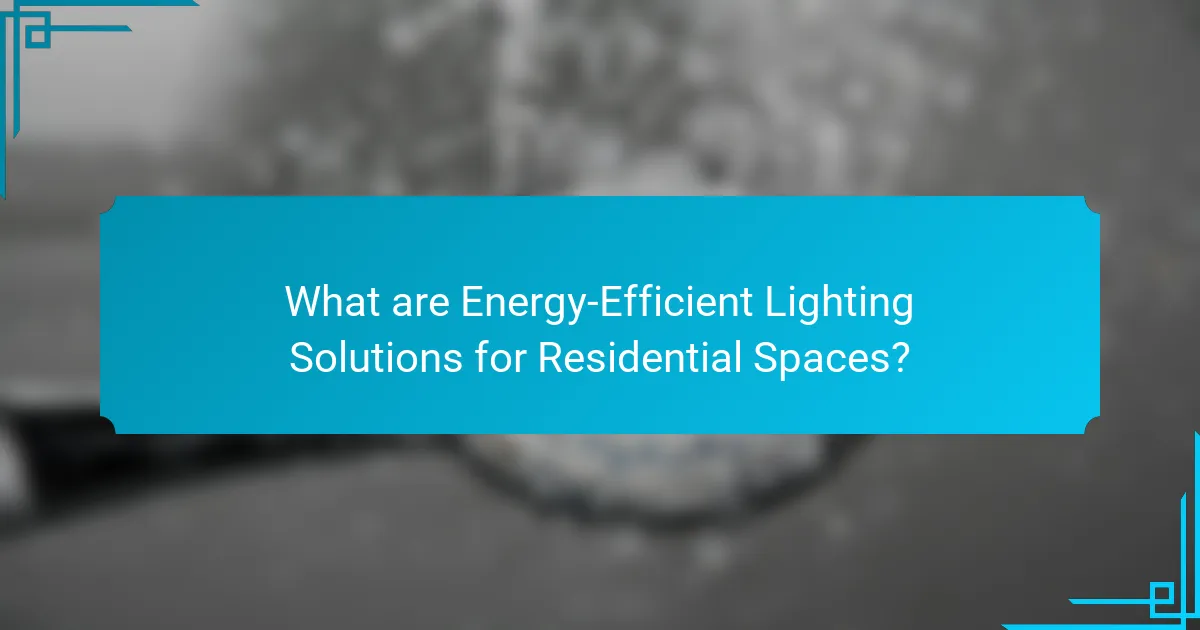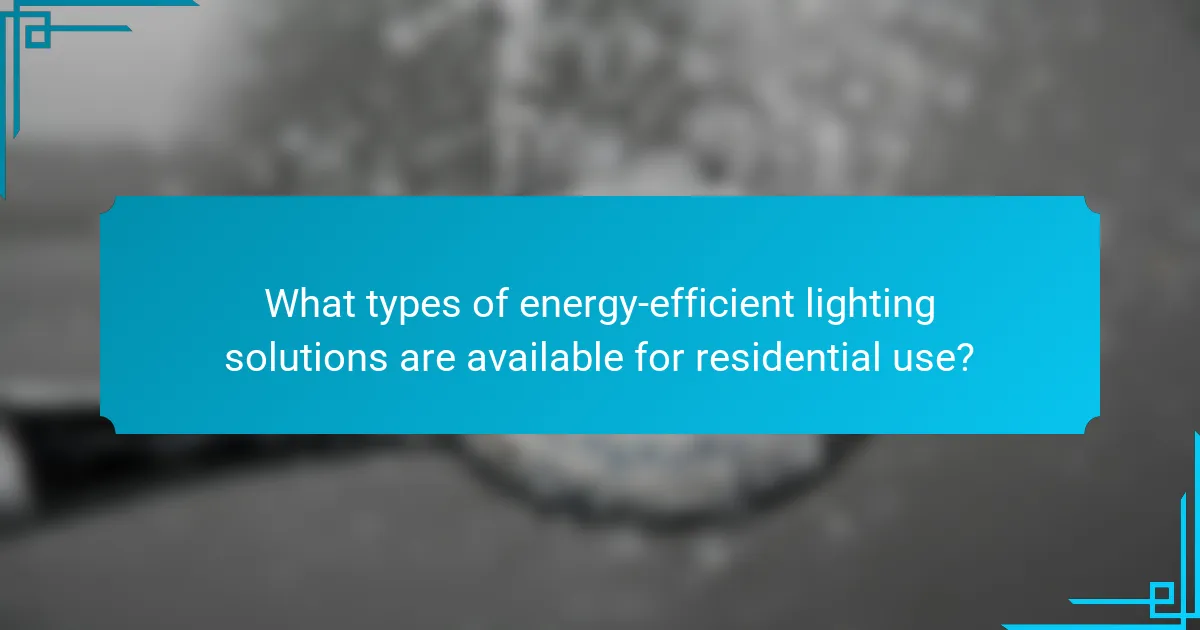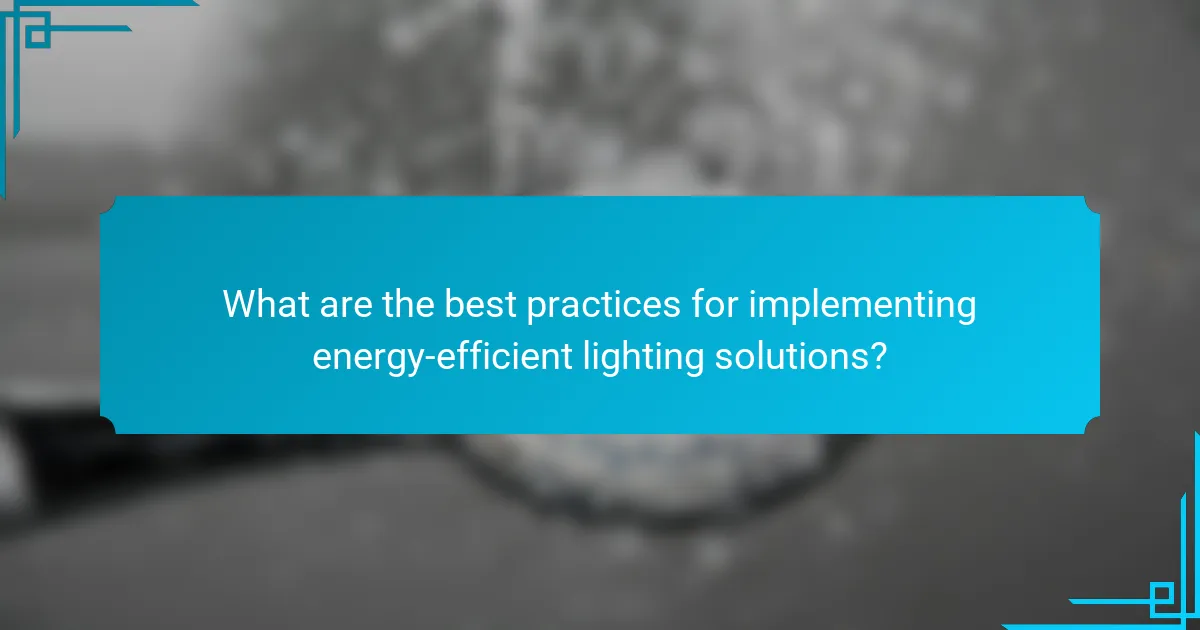Energy-efficient lighting solutions for residential spaces include LED bulbs, compact fluorescent lamps (CFLs), and smart lighting systems. LED bulbs are highly efficient, consuming up to 75% less energy than traditional incandescent bulbs and lasting approximately 25 times longer. CFLs also provide significant energy savings, using about 70% less energy with a lifespan of around 10,000 hours. Smart lighting systems enhance energy efficiency by allowing remote control of brightness and color, and can be programmed to turn off automatically when not in use. Implementing these solutions, along with best practices such as maximizing natural light and using dimmers, can lead to lower electricity bills and reduced carbon footprints for homeowners.

What are Energy-Efficient Lighting Solutions for Residential Spaces?
Energy-efficient lighting solutions for residential spaces include LED bulbs, CFLs, and smart lighting systems. LED bulbs consume up to 75% less energy than traditional incandescent bulbs. They also last approximately 25 times longer. CFLs, or compact fluorescent lamps, use about 70% less energy than incandescent bulbs. They have a lifespan of about 10,000 hours. Smart lighting systems allow users to control brightness and color remotely, optimizing energy use. These systems can be programmed to turn off automatically when not in use. Collectively, these solutions contribute to lower electricity bills and reduced carbon footprints.
How do energy-efficient lighting solutions differ from traditional lighting?
Energy-efficient lighting solutions use less energy than traditional lighting. They convert a higher percentage of energy into light rather than heat. For example, LED bulbs consume up to 80% less energy than incandescent bulbs. Energy-efficient options have a longer lifespan, lasting up to 25,000 hours compared to 1,000 hours for traditional bulbs. This results in lower replacement costs and reduced waste. Additionally, energy-efficient lighting produces less heat, contributing to lower cooling costs in residential spaces. These differences lead to significant savings on energy bills over time.
What technologies are involved in energy-efficient lighting solutions?
Energy-efficient lighting solutions involve several key technologies. These include LED (Light Emitting Diode) lighting, which uses up to 80% less energy than traditional incandescent bulbs. CFL (Compact Fluorescent Lamp) technology is another option, consuming about 75% less energy. Smart lighting systems, which allow for automated control and scheduling, further enhance energy savings. Additionally, daylighting techniques utilize natural sunlight to reduce reliance on artificial lighting. Finally, occupancy sensors help to minimize energy waste by turning off lights when spaces are unoccupied. These technologies collectively contribute to significant energy efficiency in residential lighting.
How do energy-efficient solutions impact energy consumption?
Energy-efficient solutions significantly reduce energy consumption. These solutions, such as LED lighting, use less electricity compared to traditional incandescent bulbs. For instance, LED bulbs consume up to 80% less energy. This reduction leads to lower utility bills for homeowners. Additionally, energy-efficient solutions contribute to decreased greenhouse gas emissions. According to the U.S. Department of Energy, widespread adoption of LED lighting could save over $30 billion annually in energy costs. Thus, implementing energy-efficient solutions has a direct and positive impact on overall energy consumption.
What are the benefits of using energy-efficient lighting in homes?
Energy-efficient lighting in homes reduces electricity consumption significantly. This type of lighting uses up to 80% less energy than traditional incandescent bulbs. Lower energy usage leads to reduced utility bills. For example, switching to LED bulbs can save homeowners about $225 over the lifetime of each bulb. Energy-efficient lighting also has a longer lifespan, lasting up to 25,000 hours compared to 1,000 hours for incandescent bulbs. This means fewer replacements and less waste. Additionally, energy-efficient lighting contributes to a smaller carbon footprint. By using less energy, homes can help reduce greenhouse gas emissions. Overall, energy-efficient lighting offers financial savings and environmental benefits.
How do energy-efficient lighting solutions contribute to cost savings?
Energy-efficient lighting solutions contribute to cost savings by reducing electricity consumption. These solutions, such as LED bulbs, use up to 80% less energy than traditional incandescent bulbs. Lower energy usage directly translates to lower utility bills. Additionally, energy-efficient lights have a longer lifespan, often lasting up to 25,000 hours. This longevity reduces the frequency of replacements and associated costs. According to the U.S. Department of Energy, switching to energy-efficient lighting can save an average household around $225 annually on energy bills. Overall, the combination of reduced energy consumption and longer lifespan results in significant financial savings for consumers.
What environmental advantages do energy-efficient lighting solutions provide?
Energy-efficient lighting solutions reduce energy consumption and lower greenhouse gas emissions. These solutions typically use up to 75% less energy than traditional incandescent bulbs. This significant reduction in energy use leads to decreased demand for electricity generation. Consequently, this diminishes the environmental impact associated with fossil fuel power plants. Additionally, energy-efficient lighting options have a longer lifespan, resulting in less waste in landfills. For example, LED bulbs can last up to 25,000 hours compared to 1,000 hours for incandescent bulbs. This longevity further reduces the frequency of replacements and the resources needed for manufacturing. Overall, energy-efficient lighting promotes a more sustainable environment by conserving energy and minimizing waste.

What types of energy-efficient lighting solutions are available for residential use?
Types of energy-efficient lighting solutions for residential use include LED bulbs, CFLs, and smart lighting systems. LED bulbs consume up to 75% less energy than traditional incandescent bulbs. Compact fluorescent lamps (CFLs) use about 70% less energy compared to incandescents. Smart lighting systems allow users to control lighting remotely and optimize energy use. These solutions not only reduce energy consumption but also lower electricity bills. The U.S. Department of Energy states that switching to energy-efficient lighting can save homeowners significant amounts annually.
What are the most common types of energy-efficient bulbs?
The most common types of energy-efficient bulbs are LED, CFL, and halogen bulbs. LED bulbs are known for their longevity and low energy consumption. They can last up to 25,000 hours and use about 75% less energy than incandescent bulbs. CFL bulbs, or compact fluorescent lamps, are also energy-efficient. They typically last around 10,000 hours and use about 70% less energy than traditional bulbs. Halogen bulbs are a type of incandescent bulb that is more efficient. They use about 30% less energy than standard incandescent bulbs and have a lifespan of about 2,000 hours. These three types of bulbs are widely available and contribute significantly to energy savings in residential spaces.
How do LED bulbs compare to CFL bulbs in terms of efficiency?
LED bulbs are more efficient than CFL bulbs. LED bulbs convert approximately 80-90% of their energy into light. In contrast, CFL bulbs convert about 70% of their energy into light. This difference results in LED bulbs using less electricity for the same light output. For example, a 10-watt LED bulb can produce the same brightness as a 15-watt CFL bulb. Additionally, LED bulbs have a longer lifespan, lasting up to 25,000 hours compared to 10,000 hours for CFLs. This longevity further enhances their efficiency by reducing the frequency of replacements.
What are the unique features of smart lighting solutions?
Smart lighting solutions offer unique features such as remote control, automation, and energy efficiency. These systems allow users to control lights from smartphones or tablets. They can be programmed to turn on or off based on schedules or occupancy. Smart lighting can adjust brightness and color temperature to suit different moods. Many solutions integrate with home automation systems for seamless operation. They often use LED technology, which consumes less energy than traditional bulbs. Furthermore, smart lighting can provide energy usage reports, helping users monitor consumption. These features contribute to both convenience and energy savings in residential spaces.
How can homeowners choose the right energy-efficient lighting for their spaces?
Homeowners can choose the right energy-efficient lighting by considering the type of bulbs available. LED bulbs are the most energy-efficient, using up to 75% less energy than incandescent bulbs. They also have a longer lifespan, lasting up to 25,000 hours. Homeowners should assess the brightness needed for each space, measured in lumens. A higher lumen count is ideal for areas requiring more light, like kitchens or workspaces. Additionally, homeowners should consider the color temperature of the bulbs. Warmer tones create a cozy atmosphere, while cooler tones are better for task-oriented spaces. Energy Star-rated products guarantee efficiency and performance. Checking for rebates or incentives can also help lower costs. These factors ensure homeowners select the most suitable and efficient lighting for their needs.
What factors should be considered when selecting energy-efficient lighting?
When selecting energy-efficient lighting, consider the type of bulb, brightness, color temperature, and energy consumption. LED bulbs are the most energy-efficient option available. They use up to 80% less energy than traditional incandescent bulbs. Brightness is measured in lumens; higher lumens indicate brighter light. Color temperature affects the ambiance; warmer tones (2700K-3000K) create a cozy feel, while cooler tones (4000K-5000K) provide a more clinical look. Also, check the energy label for wattage and lifespan; longer-lasting bulbs reduce replacement frequency. Finally, consider the application; different spaces may require different lighting solutions for optimal efficiency.
How do lighting needs vary across different rooms in a home?
Lighting needs vary significantly across different rooms in a home. Each room serves a unique purpose that influences its lighting requirements. For example, kitchens require bright, focused lighting for tasks like cooking and food preparation. In contrast, living rooms benefit from softer, ambient lighting to create a cozy atmosphere.
Bedrooms typically need dimmable lighting options to promote relaxation and sleep. Bathrooms require bright, even lighting for grooming tasks, often supplemented with task lighting around mirrors. Home offices need bright, focused lighting to enhance productivity and reduce eye strain.
According to the American Lighting Association, proper lighting can improve mood and functionality in each space. The varying needs are based on activities performed in each room, necessitating different lighting solutions for optimal energy efficiency and comfort.

What are the best practices for implementing energy-efficient lighting solutions?
The best practices for implementing energy-efficient lighting solutions include selecting LED bulbs, utilizing natural light, and installing dimmers. LED bulbs use up to 75% less energy than incandescent bulbs. Maximizing natural light reduces reliance on artificial lighting during the day. Dimmers allow for adjustable brightness, further conserving energy. Employing motion sensors can ensure lights are only on when needed. Using task lighting focuses illumination where it is most required, minimizing excess use. Regular maintenance of fixtures keeps them efficient and effective. These practices contribute to significant energy savings and lower electricity bills.
How can homeowners maximize the benefits of energy-efficient lighting?
Homeowners can maximize the benefits of energy-efficient lighting by selecting the right fixtures and bulbs. Choosing LED bulbs can reduce energy consumption by up to 80% compared to traditional incandescent bulbs. Installing dimmers allows for adjustable brightness, further saving energy. Utilizing natural light during the day can minimize reliance on artificial lighting. Positioning lights strategically can enhance illumination while reducing the number of fixtures needed. Regularly cleaning light fixtures ensures optimal brightness and efficiency. Homeowners should also consider smart lighting systems that can be programmed for energy savings. These practices collectively enhance energy efficiency and lower electricity bills.
What strategies can be used to improve lighting design in residential spaces?
To improve lighting design in residential spaces, consider layering light sources. This includes ambient, task, and accent lighting. Ambient lighting provides overall illumination. Task lighting focuses on specific areas for activities like reading or cooking. Accent lighting highlights architectural features or artwork.
Using dimmers can enhance flexibility in lighting levels. This allows for adjustments based on the time of day or activity. Choosing energy-efficient bulbs, such as LED lights, reduces energy consumption. LEDs use up to 75% less energy than traditional incandescent bulbs.
Incorporating natural light through windows or skylights can also improve lighting design. Natural light can enhance mood and reduce reliance on artificial lighting. Lastly, consider the color temperature of lights. Warmer tones create a cozy atmosphere, while cooler tones can energize a space.
How can homeowners maintain energy-efficient lighting systems effectively?
Homeowners can maintain energy-efficient lighting systems effectively by regularly cleaning light fixtures and bulbs. Dust and grime can reduce light output and efficiency. They should also replace burnt-out bulbs with energy-efficient options like LED or CFL. These bulbs consume less energy and have a longer lifespan. Additionally, homeowners should check for and fix any faulty wiring or connections. This ensures optimal performance and safety. Regularly using dimmers and timers can also help in managing energy consumption. Studies show that using dimmers can reduce energy usage by up to 20%. Lastly, homeowners should consider using smart lighting systems for better control and efficiency.
What common mistakes should homeowners avoid when using energy-efficient lighting?
Homeowners should avoid using energy-efficient lighting inappropriately. One common mistake is selecting the wrong bulb type for specific fixtures. For example, using non-dimmable LED bulbs in dimmer switches can cause flickering. Another mistake is neglecting to consider lumens instead of watts for brightness. Many homeowners mistakenly equate higher wattage with more light. Additionally, failing to replace outdated fixtures can limit energy savings. Old fixtures may not be compatible with new energy-efficient bulbs. Lastly, ignoring the color temperature can affect ambiance. Homeowners should choose a color temperature that suits their space, typically between 2700K and 3000K for warm lighting.
How can improper installation affect the performance of energy-efficient lighting?
Improper installation can significantly reduce the performance of energy-efficient lighting. Incorrect wiring may lead to flickering or dim lighting. Misalignment of fixtures can cause uneven light distribution. Poor placement may result in insufficient illumination in certain areas. This can increase energy consumption as lights may need to be used more frequently or at higher settings. Additionally, overheating can occur if fixtures are not installed correctly, potentially shortening their lifespan. According to the U.S. Department of Energy, proper installation is crucial for maximizing energy savings and ensuring optimal functionality.
What are the misconceptions about energy-efficient lighting solutions?
Misconceptions about energy-efficient lighting solutions include beliefs that they are too expensive and provide inadequate light. Many consumers think initial costs outweigh savings. However, energy-efficient bulbs can save up to 75% on energy costs. Another misconception is that these solutions are not dimmable. In reality, many modern energy-efficient options are compatible with dimmer switches. Additionally, some believe they have a shorter lifespan. In fact, LED bulbs can last up to 25,000 hours. Lastly, people often assume that energy-efficient lighting is only suitable for commercial use. Yet, they are designed for residential spaces and can enhance home aesthetics.
Energy-efficient lighting solutions for residential spaces include LED bulbs, CFLs, and smart lighting systems, which significantly reduce energy consumption and lower electricity bills. Key technologies such as LED and CFL use up to 80% less energy compared to traditional incandescent bulbs, while smart systems allow for remote control and automation. These solutions not only save money but also contribute to environmental sustainability by reducing greenhouse gas emissions and waste. Homeowners can maximize benefits by selecting appropriate lighting types based on room functions, utilizing natural light, and following best practices for installation and maintenance.